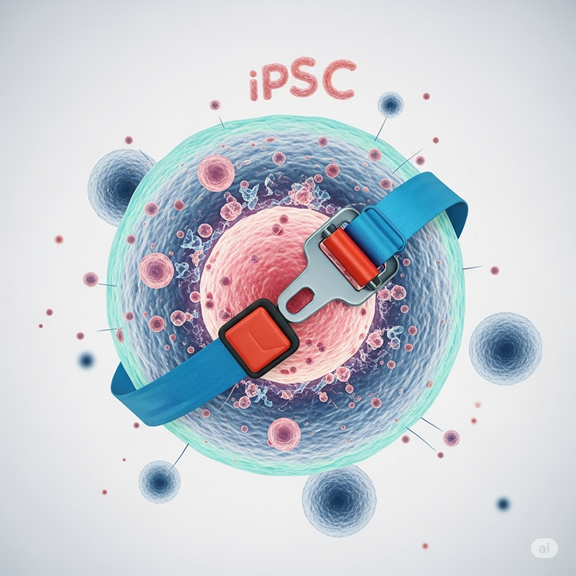FailSafe®: The Essential Safety Feature Revolutionizing iPSC-Based Therapies
Immune-Evasion Strategies in iPSC-Based Therapies: The Opportunity and The Risk
Induced pluripotent stem cells (iPSCs) have transformed regenerative medicine by offering an unlimited supply of raw materials to use in repairing and replacing damaged and diseased cells and tissues. Living medicine therapies made from iPSCs can be derived from a patient’s own cells (autologous) or from one donor for use in many patients (allogeneic). While autologous treatments offer personalized immune compatibility, allogeneic therapies present a scalable, off-the-shelf solution capable of treating many thousands of patients from a single manufacturing run—dramatically improving access and reducing costs.
However, the scale advantage of allogenic therapies also comes at a price: potential immune rejection of the “mis-matched” allogeneic therapy by the recipient. To avoid this, many developers are using one of three strategies:
- Immune sequestration using physical barriers such as encapsulation devices,
- Systemic and chronic immunosuppression of the patient, or
- Genetic engineering of the product cells to permit tolerance or evade detection and destruction by the host immune system.
Due to the risks associated with systemic immunosuppression—including increased susceptibility to infections and cancer—or the fibrotic response commonly associated with immune sequestration via an encapsulation device, the field of living medicine made from iPSCs has largely shifted toward genetic engineering approaches. A prominent strategy involves knocking out the B2M and CIITA genes. Ablation of these genes effectively blocks expression of human leukocyte antigens (HLAs) class I and II, respectively. Alternatively, induction of allogeneic cell tolerance via engineered expression of a set of factors (iACT) can render transplanted cells as tolerated and not seen to present mismatched HLAs. HLAs are cell-surface proteins that signal immune recognition; their absence or tolerance makes donor cells less visible to the host adaptive immune system. However, this invisibility carries an inherent risk.
Why Safety in iPSC Therapies Can’t Be an Afterthought
While immune-evasive engineering enables broader applicability of allogeneic therapies, it introduces a significant safety concern: If a single undetected, genetically altered cell begins to proliferate uncontrollably, it could lead to tumor formation or other serious complications. The immune system, which would normally recognize and eliminate such rogue cells, would effectively be blindfolded to their presence. In such cases, the original therapeutic benefit of the living medicine could be entirely negated, requiring aggressive interventions like chemotherapy, radiation, and surgery.
To mitigate this low-probability but high-impact risk, a built-in, controllable safety mechanism—often referred to as a “kill switch”—is essential. This allows the selective elimination of problematic cells without compromising the therapeutic effect of the engrafted tissue.
This is where FailSafe, a unique inducible safety switch, is critically important. FailSafe is designed to enhance the safety profile of cell therapies and provide a mechanism for safe long-term implantation of living cells and tissues. As more iPSC-derived therapies advance to testing in human trials, the integration of a safety strategy should become a regulatory expectation and a clinical imperative.
What is FailSafe?
FailSafe is engineered to eliminate dividing cells while sparing mature, non-dividing, therapeutic cells. It works by linking homozygous expression of a suicide gene—herpes simplex virus thymidine kinase (HSV-TK)—to a gene essential for cell division. This ensures proliferating cells from the graft will express the suicide gene and be selectively eliminated upon administration of ganciclovir (GCV), an antiviral drug, available in pill form, as a generic from most pharmacies worldwide.
When administered, GCV is phosphorylated by HSV-TK and becomes a toxic metabolite, triggering apoptosis in HSV-TK expressing cells. The FailSafe system ensures rapid and targeted removal of problematic proliferating cells, while preserving the integrity and function of the mature therapeutic tissue.
Why It Matters: Proactive Risk Mitigation and Regulatory Alignment
FailSafe addresses a fundamental challenge tied to iPSC-based living medicines. As the field progresses toward clinical application of off-the-shelf allogeneic therapies, product developers, regulators, and clinicians are demanding safety strategies to address unforeseen safety events. By enabling precise removal of unwanted proliferating cells post-engraftment, FailSafe proactively aligns with evolving regulatory expectations, enhances patient safety, and de-risks therapy development and commercialization. It transforms safety from a future unaddressed concern to an actively manageable feature.
How It’s Different: Targeted, Inducible, and Development-Centric
Unlike some other kill switch technologies that are constitutively present, potentially silenceable, and rely on less specific targeting, FailSafe is:
- Non-toxic unless triggered: The safety mechanism is inherently non-toxic to the cells until specifically triggered by the administration of GCV, ensuring that mature, non-proliferating, therapeutic cells function as intended and only proliferating cells are eliminated in the presence of GCV.
- Inducible on demand: FailSafe activation provides precise temporal control over the elimination of targeted cells, allowing intervention only when GCV is applied.
- Designed for early integration in the drug development process: FailSafe can easily be incorporated into your cell line by genetic engineering in the early stages of the cell line and product development process. This proactive approach ensures that a Safety Switch is an intrinsic feature of your therapeutic product from its inception, facilitating a robust and well-characterized safety profile built in from the outset.
By offering a precise, reliable, and regulatory-aligned safety mechanism, FailSafe supports the safe, scalable, and effective deployment of next-generation iPSC therapies.
FailSafe is available in Pluristyx’s PluriBank™ cells now via flexible licensing models for preclinical, clinical, and commercial use. Contact us to learn more.

